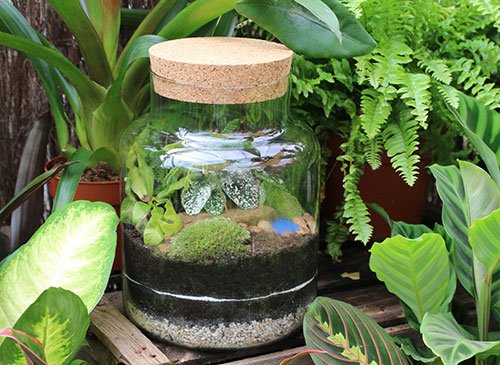Welcome to the world of terrariums! Can you use Activated Charcoal in a Terrarium? Yes, you certainly can! Using activated charcoal can be a great way to keep your miniature ecosystem healthy and thriving. By placing a layer of activated charcoal at the bottom of your terrarium, you can help absorb excess moisture and reduce unpleasant odors. This simple step can make a big difference in the overall well-being of your plants and create a beautiful environment to enjoy. So, next time you’re setting up a terrarium, don’t forget to incorporate activated charcoal to keep it looking fresh and vibrant.
Activated Charcoal In A Terrarium – How To
Have you recently started delving into the world of terrariums and are wondering about the benefits of using activated charcoal? Activated charcoal in a Terrarium is a popular due to its ability to purify the environment by absorbing impurities and odors. In this article, we will guide you through the process of using activated charcoal in your terrarium to ensure a healthy and thriving ecosystem for your plants.
What is Activated Charcoal?

Activated charcoal, also known as activated carbon, is a form of carbon that has been processed to have small, low-volume pores that increase the surface area available for adsorption or chemical reactions. This porous structure allows activated charcoal to effectively trap and remove impurities, toxins, and odors from the environment.
Activated charcoal is commonly used in terrariums to improve air quality, prevent mold and mildew growth, and remove harmful chemicals from the soil. It is especially beneficial in closed or enclosed terrariums where air circulation may be limited.
Benefits of Activated Charcoal in Terrariums
Activated charcoal offers a range of benefits when used in terrariums, including:
- Absorbing Toxins: Activated charcoal in a Terrarium can absorb toxins, chemicals, and impurities from the soil, water, and air in the terrarium, helping to create a healthier environment for plants.
- Preventing Odors: It can effectively neutralize odors and prevent the buildup of foul smells in the terrarium, keeping the space fresh and pleasant.
- Preventing Mold and Mildew: By absorbing excess moisture and preventing the growth of mold and mildew, activated charcoal can help maintain the health of plants in the terrarium.
How to Use Activated Charcoal in a Terrarium
Now that you understand the benefits of using activated charcoal in a terrarium, let’s walk through the steps of incorporating it into your plant ecosystem.
Supplies Needed
Before you begin, gather the following supplies:
- Activated Charcoal: You can source Activated Charcoal from most Home and Garden Centers. You can also find it here. Make sure it is in granular form for easier application.
- Terrarium Container: Choose a suitable container for your terrarium, ensuring it has proper drainage holes and sufficient space for your plants.
- Potting Soil: Use high-quality potting soil that is well-draining and suitable for the types of plants you will be growing.
- Plants: Select a variety of plants that thrive in terrarium environments, such as succulents, ferns, or moss.
- Decorative Elements: Optional decorative elements such as rocks, pebbles, or figurines to enhance the visual appeal of your terrarium.
Layering Activated Charcoal in the Terrarium
To effectively use activated charcoal in your terrarium, follow these steps for layering:
- Bottom Layer: Start by adding a layer of activated charcoal at the bottom of the terrarium. This layer should be at least half an inch thick to effectively filter out impurities and toxins.
- Add Soil: On top of the charcoal layer, add a layer of well-draining potting soil. The soil layer should be deep enough to accommodate the root systems of your plants.
- Plant Placement: Carefully place your plants in the soil, ensuring they are evenly spaced and have enough room to grow. Consider the lighting and watering needs of each plant when arranging them in the terrarium.
- Optional Decor: If desired, add decorative elements such as rocks or pebbles around the plants to enhance the visual appeal of the terrarium.
Maintenance Tips
To ensure the effectiveness of activated charcoal in your terrarium, consider the following maintenance tips:
- Replace Charcoal: Over time, the Activated charcoal in a Terrarium will become saturated with impurities and may lose its effectiveness. It is recommended to replace the charcoal layer every 6-12 months to maintain a healthy environment.
- Monitor Moisture Levels: Keep an eye on the moisture levels in the terrarium to prevent excess water buildup, which can lead to mold and mildew growth. Adjust your watering schedule as needed to ensure the plants are healthy.
- Prune Regularly: Trim and prune your plants regularly to promote growth and prevent overcrowding. Removing any dead or decaying foliage will also help maintain a clean and healthy terrarium environment.
Conclusion
In conclusion, Activated charcoal in a Terrarium is a valuable addition for its ability to purify the air, prevent odors, and maintain a healthy environment for plants. By following the steps outlined in this article, you can effectively incorporate activated charcoal into your terrarium and enjoy a thriving ecosystem that is both visually appealing and beneficial to plant growth. Experiment with different plant combinations and decorative elements to create a personalized terrarium that suits your style and preferences. Happy terrarium gardening!
Related Articles
Creating Terrariums with a Bog Environment
How to Create a Thriving Terrarium Ecosystem
How to Setup a Terrarium for a Class Project
Terrarium Supplies
If you enjoy this content and would like to support it further, I invite you to visit or shop through the affiliate links on the Terrarium Supplies page. We’re still growing the recommended products and oddities that we share but this small gesture helps us continue to produce quality content!

